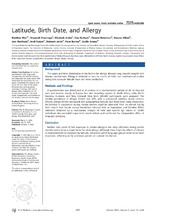| dc.description.abstract | Background: The space and time distribution of risk factors for allergic diseases may provide insights into disease mechanisms. Allergy is believed to vary by month of birth, but multinational studies taking into account latitude have not been conducted. Methods and Findings: A questionnaire was distributed in 54 centres to a representative sample of 20- to 44-y-old men and women mainly in Europe but also including regions in North Africa, India, North America, Australia, and New Zealand. Data from 200,682 participants were analyzed. The median prevalence of allergic rhinitis was 22%, with a substantial variation across centres. Overall, allergic rhinitis decreased with geographical latitude, but there were many exceptions. No increase in prevalence during certain winters could be observed. Also, no altered risk by birth month was found, except borderline reduced risks in September and October. Effect estimates obtained by a multivariate analysis of total and specific IgE values in 18,085 individuals also excluded major birth month effects and confirmed the independent effect of language grouping. Conclusion: Neither time point of first exposure to certain allergens nor early infections during winter months seems to be a major factor for adult allergy. Although there might be effects of climate or environmental UV exposure by latitude, influences within language groups seem to be more important, reflecting so far unknown genetic or cultural risk factors. | en_US |
